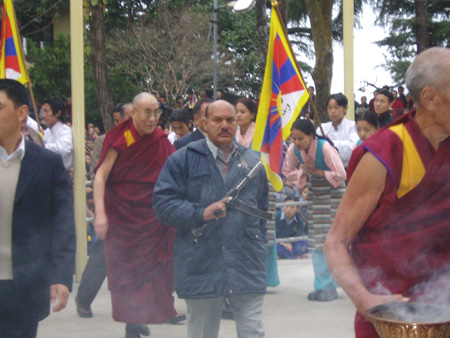
The word Losar is a Tibetan word for New Year. LO means year and SAR means new. The celebration of Losar can be traced back to the pre-Buddhist period in Tibet. During the period when Tibetans practiced the Bon religion, every winter a spiritual ceremony was held, in which people offered large quantities of incense to appease the local spirits, deities and protectors. This religious festival later evolved into an annual Buddhist festival which is believed to have originated during the reign of Pude Gungyal, the ninth King of Tibet.
The festival is said to have begun when an old woman named Belma introduced the measurement of time based on the phases of the moon. This festival took place during the flowering of the apricot trees of the Lhokha Yarla Shampo region in autumn, and it may have been the first celebration of what has become the traditional farmers’ festival. It was during this period that the arts of cultivation, irrigation, refining iron from ore and building bridges were first introduced in Tibet. The ceremonies which were instituted to celebrate these new capabilities can be recognized as precursors of the Losar festival. Later when the rudiments of the science of astrology, based on the five elements, were introduced in Tibet, this farmer’s festival became what we now call the Losar or New Year’s festival.
The calendar is made up of twelve lunar months and Losar begins on the first day of the first month. In the monasteries, the celebrations for the Losar begin on the twenty-ninth day of the twelfth month. That is the day before the Tibetan New Year’s Eve. On that day the monasteries do a protector deities’ puja (a special kind of ritual) and begin preparations for the Losar celebrations. The custom that day is to make special noodle called guthuk. It is made of nine different ingredients including dried cheese and various grains. Also, dough balls are given out with various ingredients hidden in them such as chilies, salt, wool, rice and coal.
The ingredients one finds hidden in one’s dough ball are supposed to be a lighthearted comment on one’s character. If a person finds chilies in their dough, it means they are talkative. If white-colored ingredients like salt, wool or rice are inside the dough it is considered a good sign. If a person finds coal in the dough it has much the same meaning as finding coal in one’s Christmas stocking; it means you have a “black heart”.

The second day of Losar is known as King’s Losar (gyal-po lo-sar) because officially the day is reserved for a secular gathering in the hall of Excellence of Samsara and Nirvana. His Holiness and his government in Dharmasala exchange greetings with both monastic and lay dignitaries, such as representatives of China, India, Bhutan, Nepal, Mongolia and other foreign visitors.
Then from the third day onwards, the people and monks begin to celebrate and enjoy the festive season. In Tibet before the Chinese came, Losar had been celebrated for fifteen days or more.




Thank you for your site, very interesting information!
Great to read about H.H. activity.
Lama Chenno!